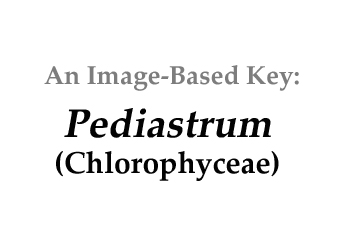|
Home / Chlorophyceae / Colonies /Non-flagellated / Pediastrum |
||||
|
|
||||
|
Click on images for larger format |
||||
Name derivation: |
||||
|
“Flat star” Flat Pedi-
star –astrum |
||||
Classification: |
||||
Pediastrum Meyen 1829; 15 of 405 species descriptions are currently accepted taxonomically (Guiry and Guiry 2013).
Order Sphaeropleales; Family Hydrodictyaceae
|
||||
Morphology: |
||||
|
Nonmotile,
multinucleated cells that can form a flat colony one cell thick. Individual cells form together with at
least 4 cells up to 128 cells in concentric rings making a flat plate that
resembles a snowflake. Cells can be
cone like or polyhedral with protrusions. The cells are often notched or
lobed, sometimes bearing short horns or bristles that can both improve its
buoyancy in the water column and help to prevent predation. The cell walls
may be smooth or ornamented. Asexual reproduction.
|
||||
Similar genera: |
||||
|
|
||||
Habitat: |
||||
|
These algae are found in lakes and ponds and along shores, where water is rich in nutrients, especially nitrogen; they are rare in deep water. Can produce taste/odor problems in drinking water.
|
||||
References: |
||||
|
Meyen, F.J.F. 1829.
Beobachtungen über einige niedere Algenformen. Nova
Acta Physico-Medica Academiae Caesareae Leopoldino-Carolinae Naturae 14:
768-778, pl. XLIII. |
||||












